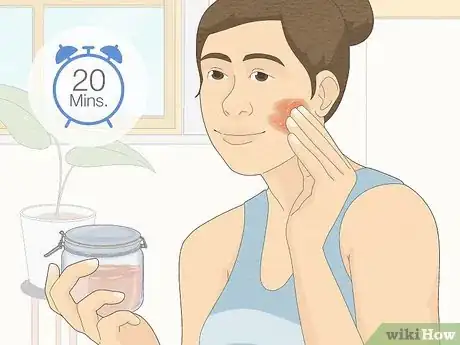This article was co-authored by Zora Degrandpre, ND. Dr. Zora Degrandpre is a Natural Health Doctor and Licensed Naturopathic Physician in Vancouver, Washington. She is a grant reviewer for the National Institutes of Health and the National Center for Complementary and Alternative Medicine. She received her ND from the National College of Natural Medicine in 2007.
There are 9 references cited in this article, which can be found at the bottom of the page.
wikiHow marks an article as reader-approved once it receives enough positive feedback. In this case, 80% of readers who voted found the article helpful, earning it our reader-approved status.
This article has been viewed 279,075 times.
You can create your own skin care treatments using common items found right in your own kitchen or garden. At-home remedies can be just as or more effective as the ones you can buy in a store, and making them yourself can also save money. It is important to test and experiment different recipes to find the best regimen for you.
Steps
Your Skin's Needs
-
1Determine your skin type. Most skin is oily, dry, combination, or normal. If your skin type is extremely oily or dry, reference general guidelines on how to care for oily skin and dry skin.
-
2Determine if your skin is sensitive to harsher ingredients. If your skin already becomes red, irritated, or acne-riddled when exposed to the sun, other skin products, or perfume, then you have sensitive skin. [1]Advertisement
-
3Determine target concerns for your skin. These might include wrinkling, acne, dull skin, or dark spots.
-
4Decide how much time and effort you want to spend on your skincare. A full skincare regimen involves exfoliator, cleanser, toner, moisturizer, and spot treatments, but you do not have to use all five. Most skin products either clean or moisturize your skin.
Natural Remedies
-
1Pick which ingredients you want to use. Below is a list of moisturizing at-home ingredients.[2] [3]
- For dry skin: olive oil, coconut oil, almond oil, cream, honey, avocado, aloe vera
- For oily skin: lemon juice diluted with water, egg white, tomatoes, shredded apple, shredded cucumber, apple cider vinegar
- For combination skin: yogurt, milk, honey, avocado, shredded apple, shredded cucumber
- For normal skin: yogurt, honey, avocado, almond oil, green tea
-
2Decide if you want to make a scrub with some of the above ingredients. Scrubs slough off dead, dull skin cells while locking moisture into the remaining skin. Most scrubs are equal parts liquid (listed above) and exfoliant (listed below):
- Sugar, brown or white
- Flour
- Oatmeal or dried oats
- Fresh strawberries
-
3Pick ingredients to treat acne if applicable. You can apply spot, leave-on treatments to acne so that your skin clears up while not irritating other skin areas. These are best applied with Q-tips or cotton balls.
-
4Pick your daily moisturizer. This can be an oil, aloe vera gel, or any other moisturizing lotion that does not aggravate your skin if left on for more than 15 minutes.
- It may seem strange to use a moisturizer that contains oil when you have acne, but oil dissolves other oils, and the sebum in acne is an oil. Many dermatologists recommend oil-based moisturizers because they are hygroscopic and attract/hold water, which will hydrate your skin.
- You can buy a moisturizer that is all-natural or organic, but not made at home.
Starting a Regimen
-
1
-
2Introduce your new regimen slowly. First try your new regimen for 1 day out of the week, then 2, then 3. Depending on your skin type and chosen ingredients, you might only need your face mask once a week, or scrub twice a week. Notice what balance is best for you.
-
3Wash your skin 1 time a day, and always moisturize right after while your skin is still damp. [9]
- If you have dry or sensitive skin, use warm water.
- Use light and gentle motions to cleanse. This may help prevent wrinkles and will not irritate your skin.
-
4Moisturize right before going to bed unless you have oily skin, so that your skin can absorb moisture while you are sleeping. This is particularly important for dry skin areas. [10]
Warnings
- If you are allergic to certain foods, don't use them in a natural skin care recipe either.⧼thumbs_response⧽
References
- ↑ http://www.medicinenet.com/script/main/art.asp?articlekey=53674
- ↑ http://www.besthealthmag.ca/best-you/home-remedies/natural-home-remedies-dry-skin#L4KWi4GLU5ZeGJzz.97
- ↑ http://www.agein.com/home-remedies-to-keep-normal-skin-looking-young-1063
- ↑ https://nccih.nih.gov/health/tea/treeoil.htm
- ↑ Michalun, V. M. , DiNardo J. (2014) Skin Care and Cosmetic Ingredients Dictionary, ISBN: 978-1-285-06079-8
- ↑ http://www.med-health.net/Lemon-Juice-For-Acne.html
- ↑ http://homemademasks.net/face-mask/by-problem/acne/egg-white-face-mask-lemon-oily-skin-acne/
- ↑ http://www.sharecare.com/health/at-home-skin-care-treatments/how-make-avocado-face-mask
- ↑ http://www.prevention.com/beauty/skin-care/dry-skin-remedies-and-prevention
About This Article
To begin a natural skincare regime, you’ll need natural ingredients to use such as yogurt, honey, avocado, and aloe vera. You can make a scrub by mixing equal parts of a natural liquid like yogurt or honey with a natural exfoliant like oatmeal or sugar. If you have acne-prone skin, you can also use lemon juice or tea tree oil as a spot treatment. It’s important to use a daily moisturizer that helps to soothe your skin. Oils or aloe vera gel are good options. When you start your natural skincare regime, introduce it slowly to see how your skin reacts to the ingredients. For more information from our Naturopathic co-author, like how to determine your skin type, read on!


















-Step-9-Version-2.webp)



-Step-1.webp)
















































